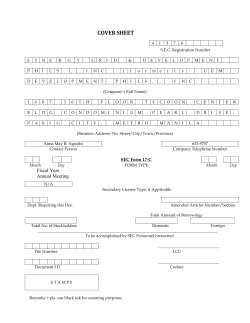
ECONOMIC PROCESSES MANAGEMENT international scientific e
ECONOMIC PROCESSES MANAGEMENT international scientific e-journal (ІSSN 2311-6293) epm.fem.sumdu.edu.ua №2 – 2015 ____________________________________________________________________ Yakimtsov V. V. Historical aspects and causes of the synergy beginning as a science [Internet source] / V. V. Yakimtsov // Economic Processes Management: International Scientific EJournal. – 2015. – № 2. – Access mode: http://epm.fem.sumdu.edu.ua/download/2015_2/2015_2_18.pdf Received 08.04.2015 УДК 330.1 JEL Classification: A13, B41, N10, O10, O30, Q50 HISTORICAL ASPECTS AND CAUSES OF THE SYNERGY BEGINNING AS A SCIENCE Yakimtsov Viktor Viktorovych PhD in Economics, Senior Lecturer of Department of Economics of Enterprise National Forestry University of Ukraine, Ukraine The article is dedicated to the historical aspects of the beginning and development of a new popular science – synergy, as a means of interdisciplinary communication among scholars. Using methodological apparatus of synergy here were considered the basics of studies. Historical aspects of the origin, beginning and formation of synergy as a science and its application in all aspects of human life were analyzed. Current research areas within synergy and nonlinear dynamics were presented. Was presented a question of order and organization of global issues (energetic, environmental, social and economic) and systems, that were developed by human using synergy. The conclusion was made on the need for a synergistic approach to all aspects of human life and especially to the economy – it is undeniable in the science of human development in society and especially within the manufacturing process. Keywords: system, synergy, dynamic chaos, attractor, self-organization, bifurcation. Introduction. Invention of computers, the development of modern computer technology have significantly influenced the research in economics and changed not only methodological approaches to economic developments, but also basic approaches to the study of economic processes in combination other processes – social, technical, natural. After all, they (processes) have an active influence on each other and together provide cumulative effect that is significantly different from the one that each of these processes should separately have. Thus, this cumulative effect should be the basis for scientists’ conclusions of on the further development of mankind. Analysis of recent research and publications. Systems that are directed in their movement to a defined state (equilibrium) are called self-organized, nonequilibrium. © V. V. Yakimtsov, 2015 ECONOMIC PROCESSES MANAGEMENT international scientific e-journal (ІSSN 2311-6293) epm.fem.sumdu.edu.ua №2 – 2015 ____________________________________________________________________ Already in the 70-ies of the twentieth century it became clear that such systems are met far and wide. Then, in 1963, the Nobel Prize R. Feynman published his research on the limited capacity to anticipate any events, even those, that perfectly described by classical mathematics [1]. Because the final result of any phenomenon is affected by any inaccuracy that eventually grows in large and unpredictable progression and unpredictably directs the development of the phenomenon. The above behavior is very specific for economic processes of human development, technology development. Dynamic chaos that was found in the systems of any nature is inherent to economic phenomena and processes as well and must be taken into account in studies of economic systems, structures, phenomena etc. In that same time Dr. Haken came up with the name of the new science – “synergy” (from the Greek – promotion) [2, 7]. In 1975 he published his first work in this field “Cooperative effects in highly unbalanced and non-physical systems”. Previously unsettled problem constituent. The popularity of this science in our time is explained by the fact, that it becomes the language of interdisciplinary communication, which speaks physicists, chemists, psychologists, sociologists, economists, despite the fact that each of them understands the synergetic model differently. Synergy can act as the methodological basis of modeling and research of economic processes as complex nonlinear systems. Main purpose of the article. Is to consider the historical background and causes of becoming of synergy as a science and as a main methodology of research in synergy. Results and discussion. For the first time, whatever ironic it would be, ideas of the new science that further has been called the “synergy” were formulated in a fantastic story of the famous American science fiction writer Ray Bradbury “A Sound of Thunder” in 1963 [3]. In this story, one of the organizers of the electing campaign after the winning of his candidate goes on a journey in time. The company that organizes this trip offers hunting for dinosaurs, which are destined to die soon. In order not to disrupt the complex fabric of causation and not change the future, you should move on special paths. But the hero was unable to fulfill this condition and accidentally squashed a golden butterfly. Returned back, he saw, that composition of the atmosphere, spelling and result of the electing campaign had changed. Barely noticeable movement knocked small dominoes, they knocked other dominoes of a little bigger size, and finally, falling of giant domino tiles led to a disaster. The little creature, golden butterfly, could cause big consequences. Breaking the balance (slightly, in very small values) in one place eventually turned into a big chaos – dynamical chaos. Mathematicians call such properties of the event “The Butterfly Effect” – sensitivity to output data. Chaos theory that was born on this principle- ECONOMIC PROCESSES MANAGEMENT international scientific e-journal (ІSSN 2311-6293) epm.fem.sumdu.edu.ua №2 – 2015 ____________________________________________________________________ effect shows that a beat of a butterfly wing in one side of the globe can cause a hurricane in another. Also in 1963, meteorologist E. Lorentz proposed a model of air convection, which was described by a system of differential equations, which was counted several times and that have not gave identical values, because the scientist changed the output data. First he took them in six-figure order, then – increasing the order. That is how was formulated the phenomenon of dynamical chaos, resulting in the establishment of the forecast terminating horizon [4]. Edward Lorenz is a meteorologist at Michigan Technological Institute, who, using a mathematical equation, managed to calculate an unusual system describing atmospheric phenomena. When he depicted it graphically, he received quite a strange object in the three-dimensional coordinate system, which he called “strange attractor” [4]. z x y Fig. 1. “Strange attractor” This image, which resembles an owl mask or butterfly wings, became an emblem of the first dynamic chaos researchers. It reveals the fine structure that lies in the chaotic flow of information. Change of the value of any variable can be displayed graphically depending on time. To demonstrate the changeable relationship between three variables, it is to assume that at any time three variables fix a point in threedimensional space; as the system changes, moving point describes a continuous line. Since the state of the system never exactly repeats itself, the trajectory never crosses itself forming new loops. Movement in the attractor is abstract, but it conveys movement features of real systems. For example, transition from the one of attractor ECONOMIC PROCESSES MANAGEMENT international scientific e-journal (ІSSN 2311-6293) epm.fem.sumdu.edu.ua №2 – 2015 ____________________________________________________________________ “wings” to another corresponds to the beginning of the reverse motion of water wheel or to change of direction of fluid rotation while the convection. The content of the name “strange attractor” lies in the fact, that system (the phenomenon) on one hand is subject to the strict laws (dynamics, development, etc.) that should keep the system in balance – but instead of regular movement to the point of equilibrium, the system demonstrates the behavior similar to a chaotic and unpredictable. System parts are “approximately” close to equilibrium, but their behavior can not be predicted – when and how did this equilibrium is to be reached. Synergy was defined as an interdisciplinary science that studies open systems with nonlinear behavior, which are far from the equilibrium and are capable of “quasi-chaotic dynamics” and self-determined generation of complex structures. The latter capability was called self-organization. Instead of understanding of the equilibrium point, which is typical for classical science, synergy uses the idea of stable unbalanced structures. Synergy studies cumulative action of many subsystems (preferably of the same or slightly different types), resulting on the macroscopic level in a new structure (phenomenon) and its proper functioning with the result and a new quality level. On the other hand, to define general principles, which govern self-organizing systems, cooperation of many different disciplines and areas of expertise is needed. Synergy is quite new generalizing science, studying the laws of selforganization of complex systems. This science includes the following disciplines: nonlinear dynamics, chaos theory, fractals, catastrophe theory, bifurcation, waves, field effects etc. Main mathematical research methods in synergy belong to theory of dynamic systems, which is based on the qualitative theory of differential equations. Among the modern areas of research within synergy and nonlinear dynamics, we can distinguish the following: – methods basing on statistical physics, describing essentially non-equilibrium processes; – thermodynamics of open systems, that studies the conditions being kept stable in a certain range of changes of external influences and explores the conditions of self-organization – formation of the ordered structures out of disordered; – study of qualitative behavior of solutions of nonlinear differential equations that determine the conditions far from equilibrium, depending on changes of input parameters. This line of research was titled the catastrophe theory. Unauthorized forming systems, structures and phenomena are called dissipative structures. I.P. Pryhozhyn proposed this term when he studies dissipativity of phenomena, systems and structures. Dissipativity is a special dynamic condition of the open unbalanced systems that actively interact with the environment, can acquire special properties due to numerous micro-processes within them and result to an ECONOMIC PROCESSES MANAGEMENT international scientific e-journal (ІSSN 2311-6293) epm.fem.sumdu.edu.ua №2 – 2015 ____________________________________________________________________ integral result on a macro-level. In such systems the result is very different from the results that may be received in each part of the system. Thanks to dissipativity in unbalanced systems, new types of structures can spontaneously emerge, transitions from chaos to order and organization can take place, etc. [5]. Self-organizing systems are rather complicated systems with a large number of degrees of freedom, options, features etc. However, not all of them equally affect the final result of the system, and in the process of self-organization there appear new features having more significant impact on the final result. All this is due to imbalance of the system. Therefore, determining the parameters and their values (order) is essential and of decisive importance while the modeling of such systems. It is fundamental and basic task for synergy researches. Systems existing in nature differ significantly from those created by human. First ones, as a rule, are stable and capable of self-improvement. Second ones are very sensitive to errors, external factors changes and can not improve themselves (human impact is required). The issue of improving the systems developed by man is the main one in synergy. Optimization of order and organization is particularly acute in the study of global issues – energetic, environmental, social and economic. Men must correctly and clearly define the internal qualities of system, laws of its development and so on. The main idea of synergy is an idea of the fundamental possibility of order and organization or other phenomenon appearance out of chaos in the process of selforganization. An important factor of self-organization is formation of connection between the system and environment where it exists. At that, system shall organize itself in the environment in such a way to resist destruction. Such phenomena exist in nature as well. Man's task when creating self-organizing systems is to coordinate them with nature and the environment. Improving of self-organizing systems is a complex process and sometimes it is defines by seemingly unimportant, small, random factors. But their interaction results in quite a different process – the factors, that seem insignificant, influence on the final result of the system development in such an unexpected way that the system itself acquires different meaning and significance. The system organizes itself not in simple way – but it happens inevitably and for sure. The process of self-organization experiences favorable moments, influence factors and turning-points, actions, impacts that will have negative, as well as positive, result. These points are called bifurcation points (lines) – that are parameters of the system whereby the sustainability stability of the system is broken. They became unstable in relation to fluctuations of the system. Fluctuations are microscopic changes in the system that do not lead to macroscopic changes in the ECONOMIC PROCESSES MANAGEMENT international scientific e-journal (ІSSN 2311-6293) epm.fem.sumdu.edu.ua №2 – 2015 ____________________________________________________________________ state close to equilibrium, but those that affect the evolution of the system in case of its entering into the bifurcation points. In the vicinity of bifurcation points in the system there are significant fluctuations1 observed, the role and importance of random factors rises, etc. At such moments the process of self-organization is quite unpredictable. It is not known whether the system will further become ordered or it will become chaotic and unpredictable. Then revolutionary changes of system, that will provide its perfect different quality and nature, are possible Conclusion and further researches directions. Today scientists increasingly have to deal with the phenomena where more intensive external influence leads to a qualitatively new system behavior. New methods to address these challenges are needed, namely nonlinear mathematical models. Such models analysis is required in solving many problems, especially in sociology, psychology, ecology and economy and so on. Such analysis is the main in synergy. Given that synergy is an interdisciplinary science, based on the junction and result of many fields of science, it becomes clear, that economy – science of human development in society and especially within the manufacturing process – needs precisely this, synergetic, approach. References 1. Feynman R.B. (2013). Radost' poznanyya [Joy of cognition]. M.: AST. [in Russian]. 2. Khaken H. (1980). Synerhetyka [Synergetics]. M.: Myr,. [in Russian]. 3. Bredberi Rey (2013). I hryanuv hrim [A Sound of Thunder]. Harper Collins. [in Ukrainian]. 4. Lorents E. (1981). Determynyrovannoe neperyodycheskoe techenye // Strannye attraktory. [Determination of residual currents // Strange Attractors]. M.: Myr. [in Russian]. 5. Pryhozhyn Y. (1986). Poryadok iz khaosa: Novyy dyaloh cheloveka s pryrodoy. [Order out of chaos. The new dialogue between man and nature]. Obshch. red. V. Y. Arshynova & Yu. L. Klemontovycha & Yu.V.Sachkova. M. : Prohress. [in Russian]. 6. Kapytsa S. P. & Kurdyumov S. P. & Malynetskyy H. H. (2003). Synerhetyka i prohnozy budushcheho. [Synergetics and forecasts for the future]. Izd 3-e. – M.: Edytoryal URSS,. [in Russian]. 7. Khaken, H. (1991). Informatsyya i samoorhanyzatsyya. [Information and selforganization]. M. [in Russian]. 1 Fluctuation (disturbance, continuous motion, divergence) – random deviation of some value from its average meaning ECONOMIC PROCESSES MANAGEMENT international scientific e-journal (ІSSN 2311-6293) epm.fem.sumdu.edu.ua №2 – 2015 ____________________________________________________________________ ІСТОРИЧНІ АСПЕКТИ ТА ПРИЧИНИ ВИНИКНЕННЯ СИНЕРГЕТИКИ ЯК НАУКИ Якімцов Віктор Вікторович кандидат економічних наук, старший викладач кафедри економіки підприємства, Національний лісотехнічний університет України, Україна Стаття присвячена історичним аспектам виникнення та розвитку нової популярної науки – синергетики, як засобу міждисциплінарного спілкування науковців. Розглянуто основи дослідження за допомогою методологічного апарату синергетики. Проаналізовано історичні аспекти зародження, виникнення та становлення синергетики, як науки та застосування її у всіх аспектах життєдіяльності людини. Подано сучасні напрямки досліджень у рамках синергетики та нелінійної динаміки. Представлено питання впорядкованості і організації глобальних проблем (енергетичних, екологічних, соціальних, економічних), систем , що розроблені людиною за допомогою синергетики. Зроблено висновок про необхідність застосування синергетичного підходу у всіх сторонах життєдіяльності людини і зокрема у економіці – науці про розвиток людини в суспільстві і особливо у процесі виробництва є просто беззаперечним. Ключові слова: система, синергетика, динамічний хаос, аттрактор, самоорганізація, біфуркація. ИСТОРИЧЕСКИЕ АСПЕКТЫ И ПРИЧИНЫ ВОЗНИКНОВЕНИЯ СИНЕРГЕТИКИ КАК НАУКИ Якимцов Виктор Викторович кандидат экономических наук, старший преподаватель кафедры экономики предприятия, Национальный лесотехнический университет Украины, Украина Статья посвящена историческим аспектам возникновения и развития новой популярной науки – синергетики, как средства междисциплинарного общения ученых. Рассмотрены основы исследования с помощью методологического аппарата синергетики. Проанализированы исторические аспекты зарождения, возникновения и становления синергетики, как науки и применения ее во всех аспектах жизнедеятельности человека. Подано современные направления исследований в рамках синергетики и нелинейной динамики. Представлены вопросы упорядоченности и организации глобальных проблем (энергетических, экологических, социальных, экономических), систем, разработанных человеком с помощью синергетики. Сделан вывод о необходимости применения синергетического подхода во всех сторонах жизнедеятельности человека и в частности в экономике – науке о развитии человека в обществе и особенно в процессе производства просто безоговорочным. Ключевые слова: система, синергетика, динамический хаос, аттрактор, самоорганизация, бифуркация.
© Copyright 2025









